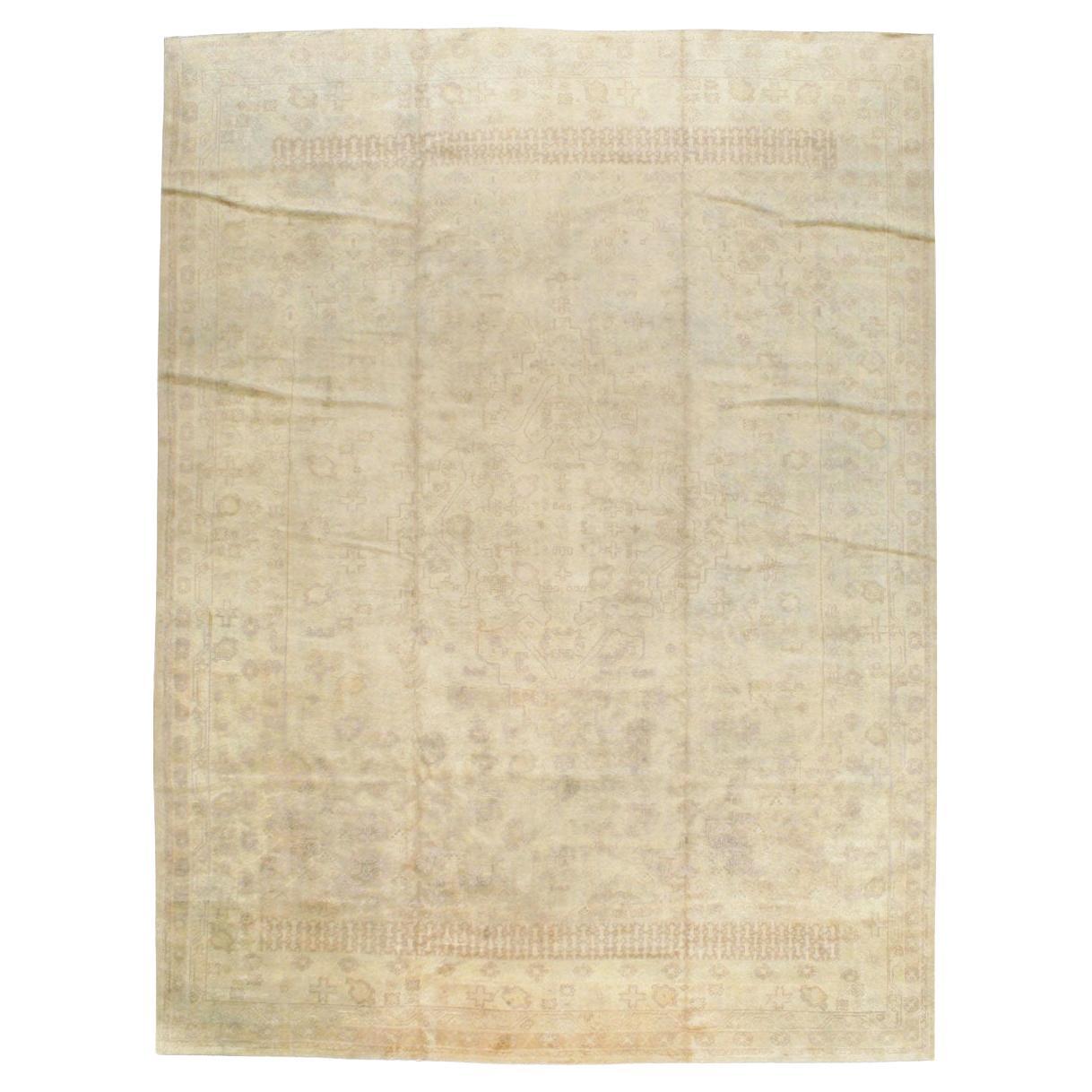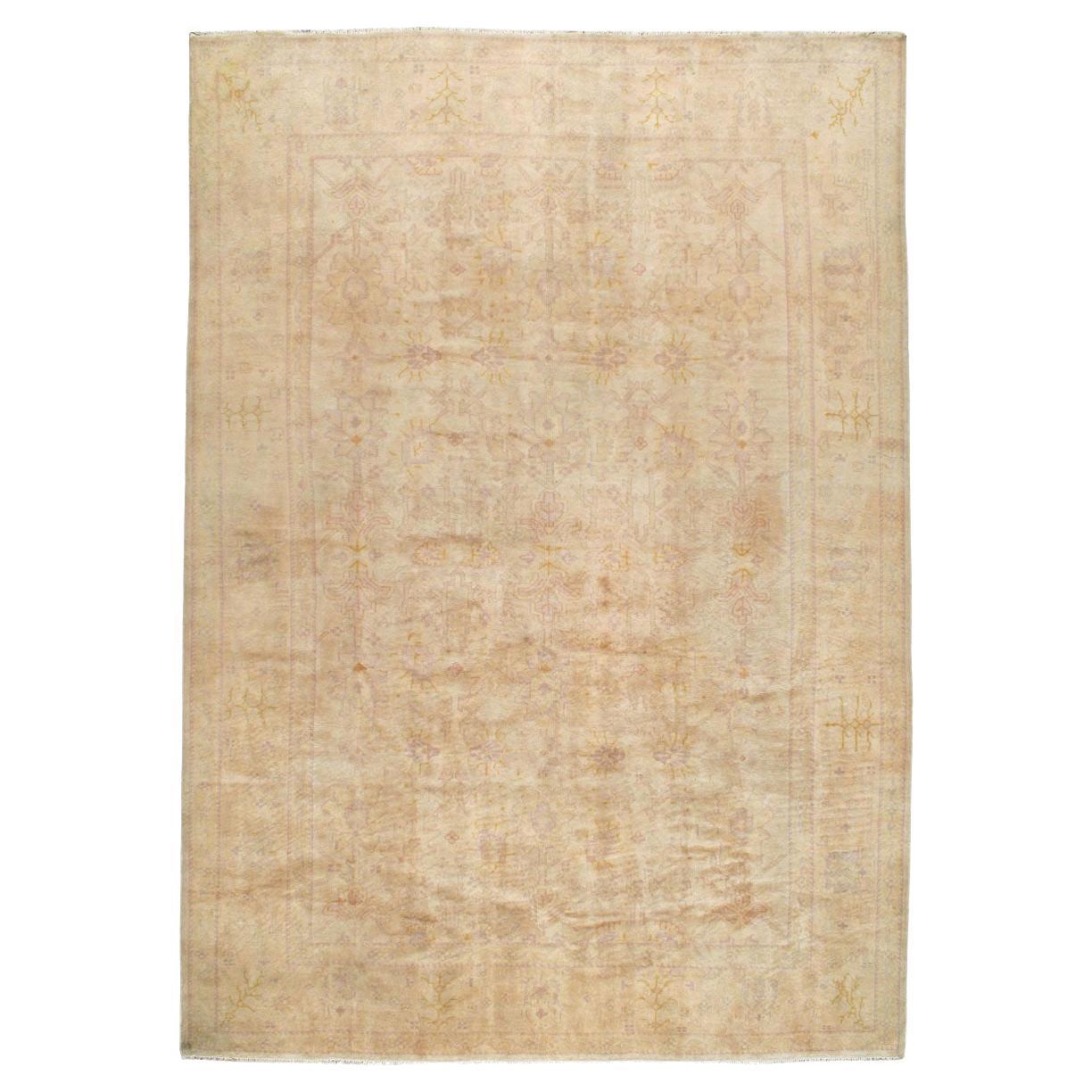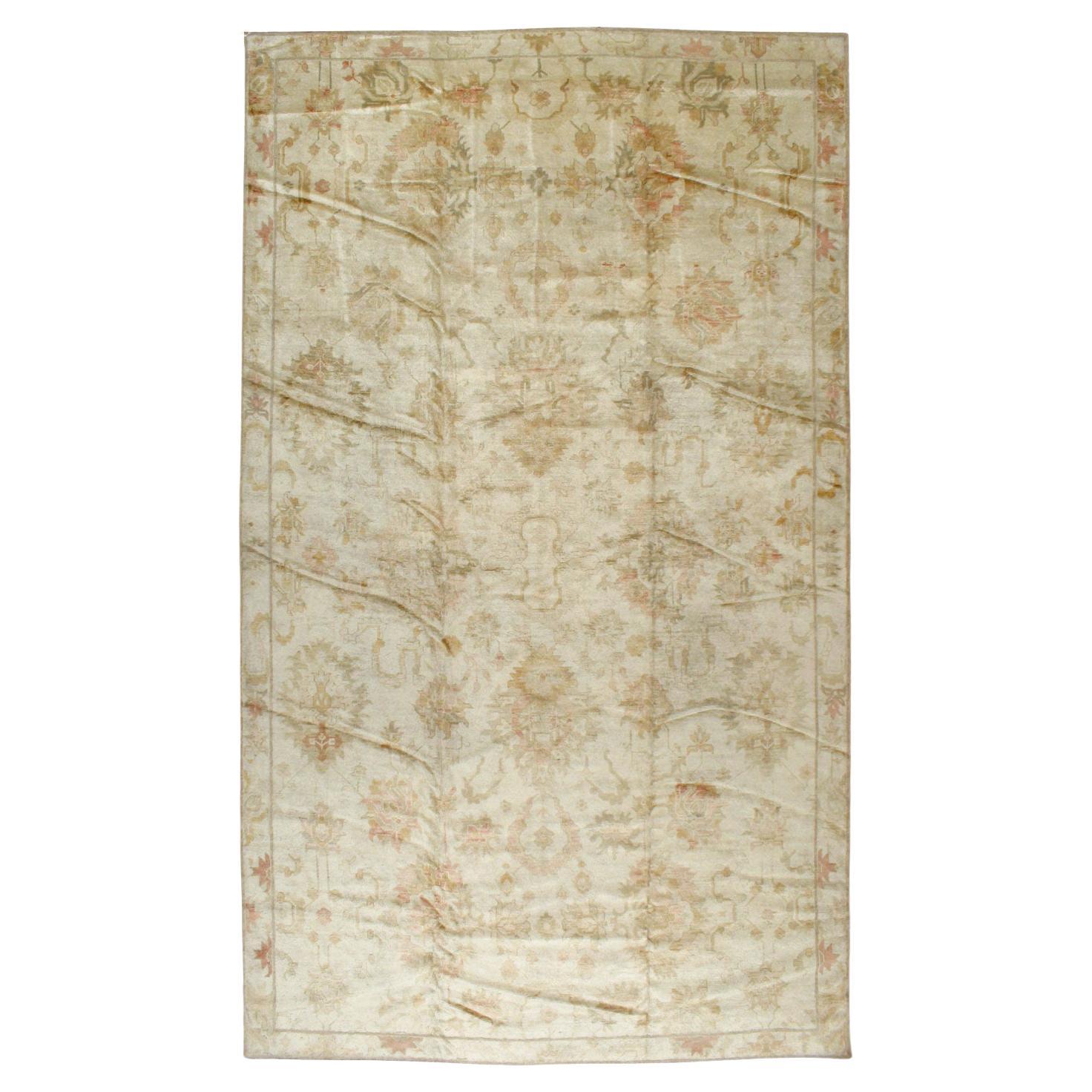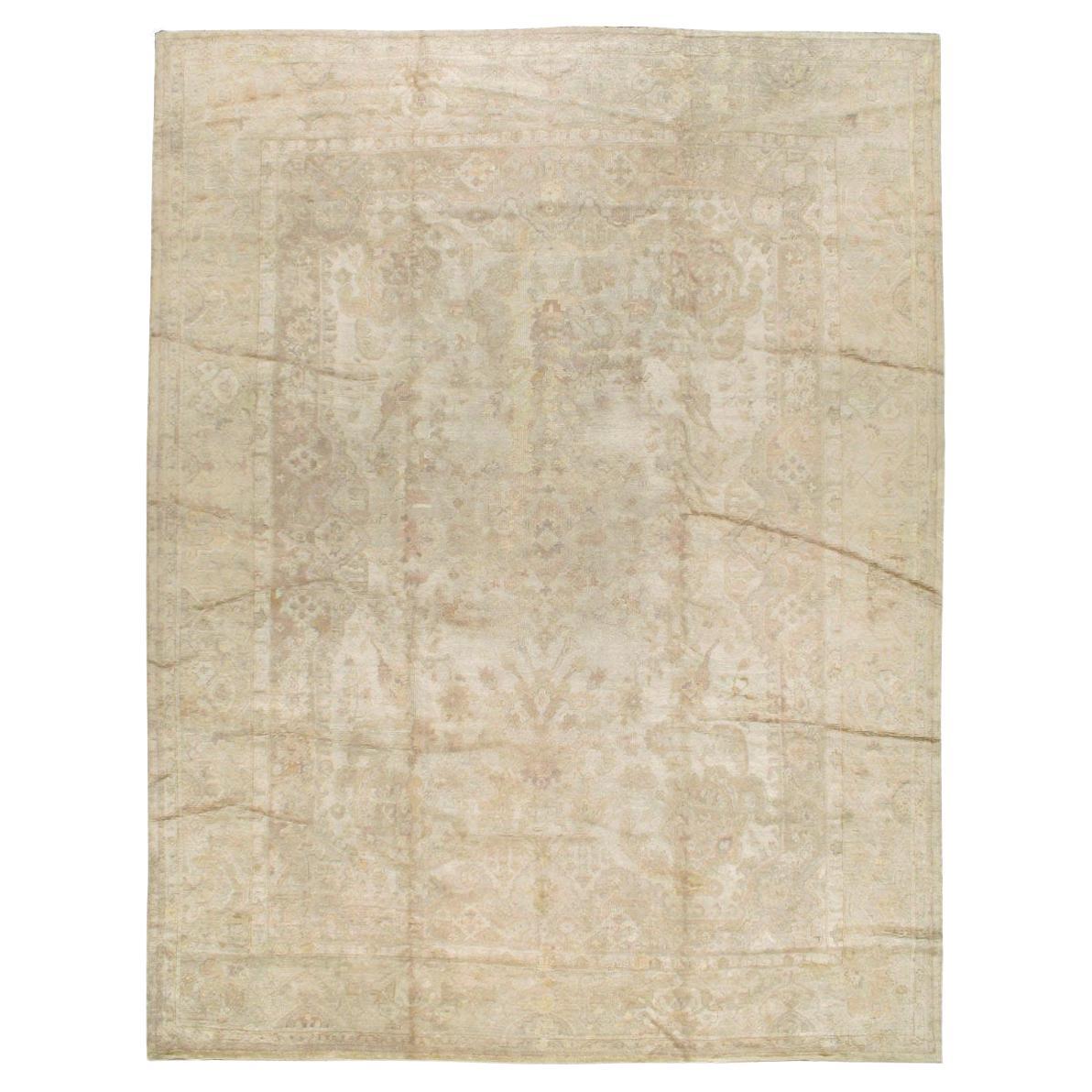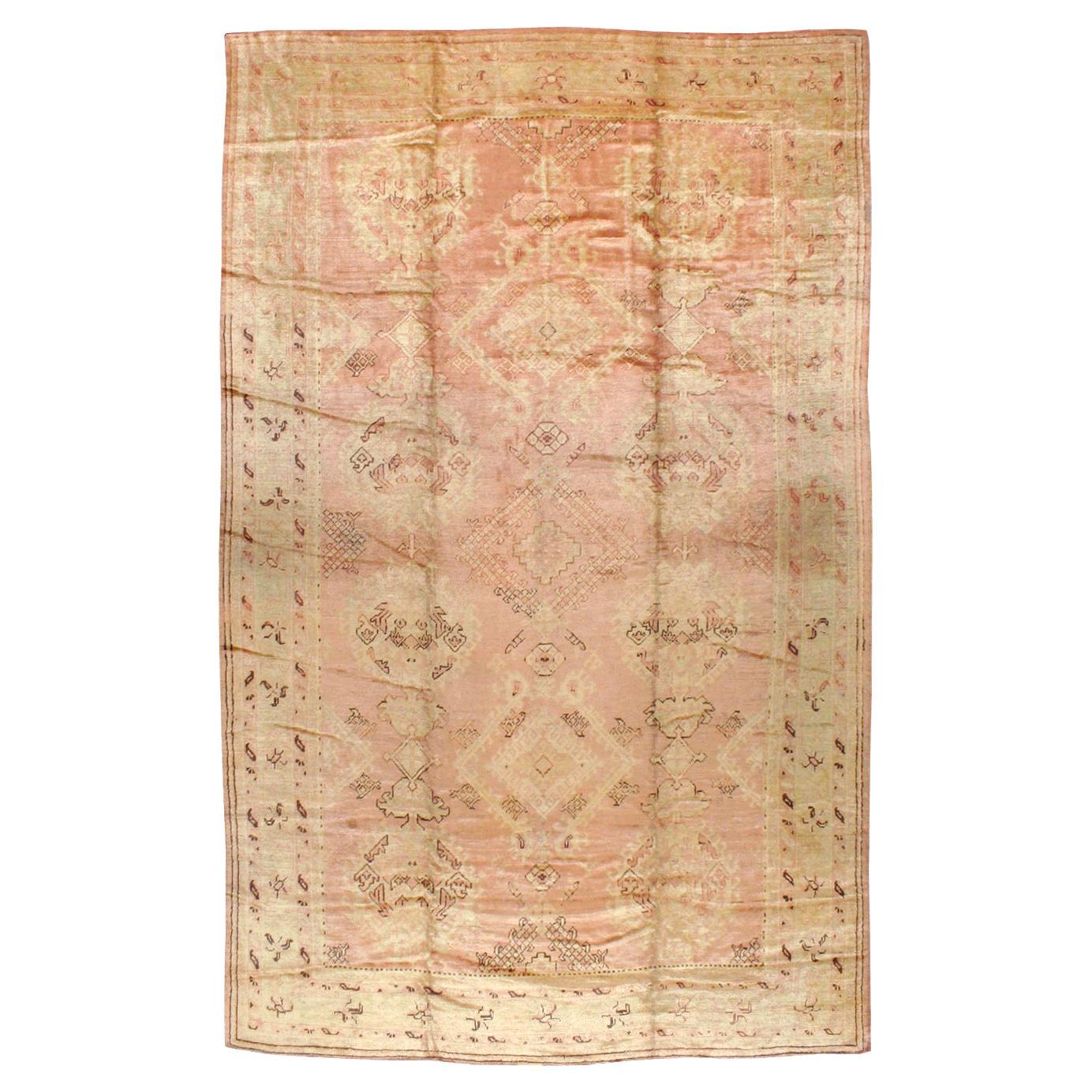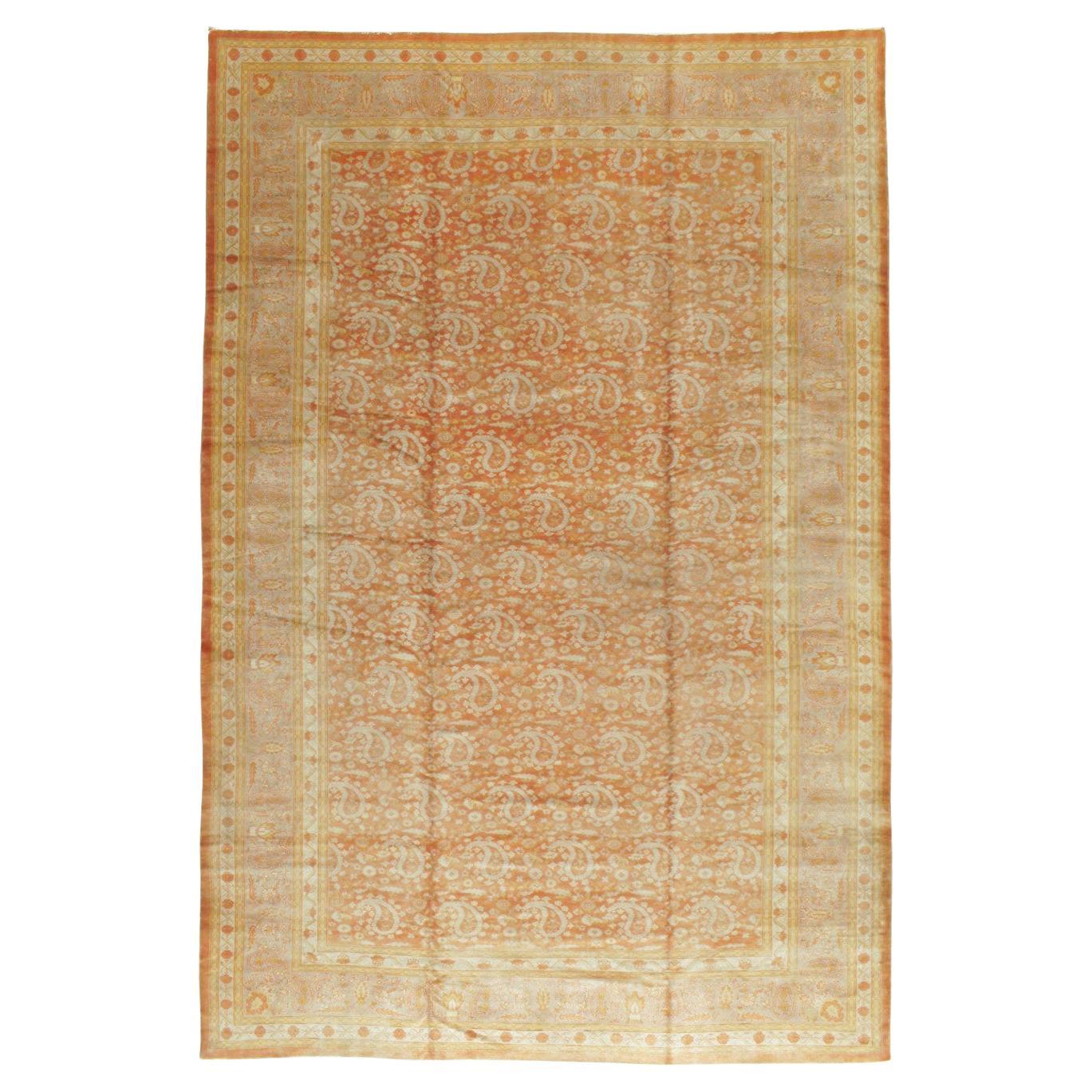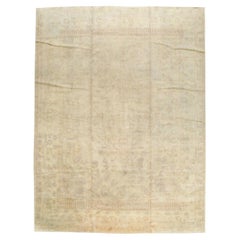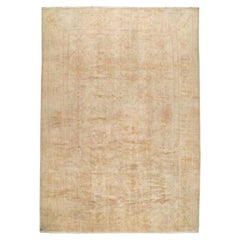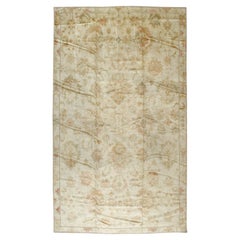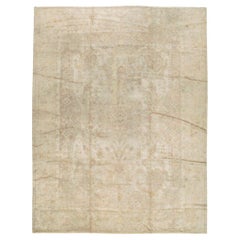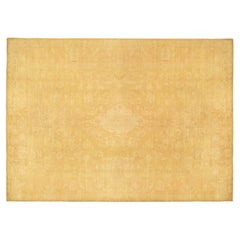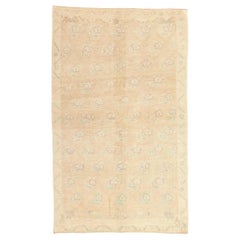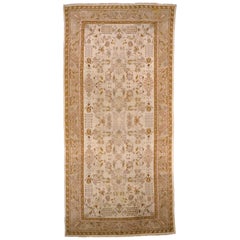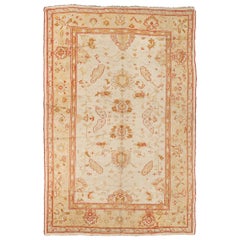Items Similar to Early 20th Century Handmade Turkish Oushak Room Size Carpet
Want more images or videos?
Request additional images or videos from the seller
1 of 11
Early 20th Century Handmade Turkish Oushak Room Size Carpet
$21,750
£16,520.90
€19,037.68
CA$30,629.39
A$33,957.20
CHF 17,845.84
MX$415,580.49
NOK 222,876.34
SEK 209,191.75
DKK 142,104.46
About the Item
An antique Turkish Oushak room size carpet handmade during the early 20th century.
Measures: 10' 3" x 12' 10"
Turkish Rugs & Carpets:
Until the Great Persian Carpet Revival in the later 19th century, the “Oriental rug” was Turkish. For nearly six centuries, Turkish rugs, both scatter, room size, and even larger, thoroughly dominated the European import market. Whereas the Persian carpet can be divided into urban, village, and tribal types, in Turkey and its predecessor the Ottoman Empire, rugs almost exclusively came from village weavers and from a small number of urban workshops. Ninety percent village, nine percent city, one percent tribal.
Turkish weavers have, with very few exceptions, always worked with the symmetric (Turkish) knot. Wool foundations are standard practice among both town and village weavers. The exceptions, very finely woven 20th century and recent Herekeh silks from near Istanbul, and early 17th century Ottoman Court rugs from Bursa, constitute only a tiny part of the total. Always pricey, they appealed and still appeal to the clients who want lots of knots and perfect execution instead of individual personality.
The urban workshops have been centered around the western Turkish city of Oushak and its attendant port town of Smyrna. Oushak weaves with the trends in fashion. When color saturated medallion carpets were needed, Oushak was ready in the 17th and 18th centuries. When coarse red and blue carpets were required, Oushak and Smyrna in the 19th century wove them by the boatload. When tastes changed again, and the European dealers in Smyrna wanted room size carpets with lighter and unusual colors, and with Persianate designs, production ramped up in nearby Oushak. Those antique, all-wool construction turn-of-the-century carpets are still in high demand with designers. Antique carpets with allover, roughly drawn patterns on grounds of shrimp, rust, straw, cream, pale blue, and pale and pea green, hitherto unavailable colors, are in such demand today that contemporary Oushaks have attempted to mimic them with soft palettes, extra-large scale drawing and coarse weaves.
Oushaks woven for the Turkish market, for palaces, houses and mosques were often oversize with large, repeating medallions, all in shades of (Turkey) red, dark blue, light blue-teal, and ivory, with lemon and green accents. Turkey, along with India, invented standard sizes. By vertically repeating the medallion, one could get one medallion, one with two end halves, two, three, etc. medallions, up to thirty or so feet in length. The process spared making new cartoons for each length and allowed a quicker turnaround time. Oushak, from the time of 15th century “Holbein” rugs onward, has always been a commercial center.
The prayer niche directional rug is primarily a Turkish development. In the towns and villages east of Oushak, in Ghiordes, Kula, Ladik, Kirsehir, Mucur and Konya, among others, arch pattern scatters with bright palettes and weaves varying from relatively fine to moderate were almost the entire production. Antique examples were particularly popular in America around 1900.
Other centers of village weaving were situated on the western coast and adjacent islands with the town of Melas and neighboring villages weaving geometric prayer rugs and scatters with a characteristic khaki green and lots of yellow.
The other large region was in the northwest of Anatolia, near ancient Troy, with the sizable town of Bergama at its center. The satellite towns of Ezine, Karakecilli, Yuntdag, and Canakkale all wove colorful scatters with moderate weaves in all wool with geometric designs and cheerful palettes. Near to Istanbul, these were among the first Turkish rugs to reach Europe in the Renaissance.
The earliest Turkish pieces depicted in Italian Old Master paintings display the so-called “Memling gul”, an allover panel pattern with hooked and stepped elements within the reserves. This pattern continues for centuries in the Konya area and in the Caucasus as well.
Turkey is a land of villages and much of the most interesting Turkish weaving comes from one undiscovered village or another. The Konya-Cappadocia region of central Turkey includes the active towns of Karapinar, Karaman, Obruk, Sizma, and Tashpinar, all weaving Konya-esque scatters and long rugs. Karapinar has been active the longest, since the 17th century. The mosques in and around Konya have preserved locally-made rugs from the fourteenth. In the 20th century, the extra-long pile, many wefted Tulu rug was devised, with limited palettes and color block patterns. These are not really antique Tulus, but they must be a product of long-standing village tradition.
There are thousands upon thousands of rural Turkish villages, almost all with easy access to local tribal wool. Rug students are discovering new names and rug types almost daily. The common denominators are bright colors, geometric designs, wool construction, moderate to coarse weaves and symmetric knots. Synthetic dyes hit the Turkish rug industry quickly and hard after 1870, and they penetrated to even the most off-the-beaten-track villages. This development was almost entirely negative. The village weavers used fugitive or overly bright dyes which ruined the color harmonies built up over centuries. Characteristic types disappeared or were negatively transmuted. The Turkish village rug of the 1870 to 1920 period is nothing to be proud of.
In the eastern provinces, the semi-nomadic Kurdish tribes, collectively called ‘Yuruks’, weave all wool, geometric pieces with medium to medium-coarse weaves, as well as kilims and other flatweaves. The rugs employ cochineal instead of madder for the reds, mustard yellows, greens, and various blues. They are under-collected like the Persian Afshars. Their rugs are in scatter and long rug formats. The far eastern Turkish town of Erzerum has a long tradition of idiosyncratic, semi-workshop rugs and further to the east is Kars with a tradition of rugs in the Caucasian Kazak manner.
One Turkish specialty is the Yastiks or cushion cover, made in pairs for the public living rooms of village houses. These are larger rugs in miniature and good ones are highly collectible. Like other Turkish rustic weavings, ones with synthetic dyes are almost totally undesirable. Only the tribal Baluch make similar cushion covers, known as pushtis or balishts, in the same small, oblong format. Yastiks always have a back, usually in plain weave, so that they can be easily stuffed.
When the Imperial Carpet Factory at Herekeh near Istanbul closed in the early 20th century, the highly proficient Armenian master weavers set up in the Kum Kapi district of Istanbul where they wove all-silk, exquisitely fine and elaborately detailed small pieces, sometimes enriched with metal thread, for the most discriminating European buyers. Today the best, signed Kum Kapi pieces, usually in the “Sultan’s head” prayer niche design, can fetch upwards of $100,000. They are strictly for the wall. An Interwar all-silk room size Kum Kapi carpet is both exceedingly rare and stratospherically priced. The workshops closed in the 1930s, but the weaving of extremely fine, all-silk small rugs in Herekeh was revived in the 1960s.
There has been a recent vogue for larger Turkish village vintage carpets (between 80 and fifty years old) with simplified bold designs and palettes mixing earth tones with bits of brighter color. These seem to come from the area around Konya or around Kars in eastern Turkey. Turkish semi-antiques also include composite strip, flatwoven carpets from the eastern tribes.
The industry/craft/art is alive and well. With a substantial population of lower-income villagers, the supply of labor, 90% of a rug’s cost, is secure. Mode4n Turkish weavings include close interpretations of long-pile Moroccans, naturally dyed scatters (begun with the DOBAG Project, softly colored Oushaks, and various flatweaves and mixed technique pieces.
- Dimensions:Width: 123 in (312.42 cm)Length: 154 in (391.16 cm)
- Style:Edwardian (In the Style Of)
- Materials and Techniques:Wool,Hand-Knotted
- Place of Origin:
- Period:
- Date of Manufacture:Early 20th Century
- Condition:Additions or alterations made to the original: This carpet has been professionally antique washed to soften its tonality.
- Seller Location:New York, NY
- Reference Number:Seller: 93821stDibs: LU882324546092
About the Seller
5.0
Platinum Seller
Premium sellers with a 4.7+ rating and 24-hour response times
Established in 1989
1stDibs seller since 2009
599 sales on 1stDibs
Typical response time: <1 hour
- ShippingRetrieving quote...Shipping from: New York, NY
- Return Policy
Authenticity Guarantee
In the unlikely event there’s an issue with an item’s authenticity, contact us within 1 year for a full refund. DetailsMoney-Back Guarantee
If your item is not as described, is damaged in transit, or does not arrive, contact us within 7 days for a full refund. Details24-Hour Cancellation
You have a 24-hour grace period in which to reconsider your purchase, with no questions asked.Vetted Professional Sellers
Our world-class sellers must adhere to strict standards for service and quality, maintaining the integrity of our listings.Price-Match Guarantee
If you find that a seller listed the same item for a lower price elsewhere, we’ll match it.Trusted Global Delivery
Our best-in-class carrier network provides specialized shipping options worldwide, including custom delivery.More From This Seller
View AllGalerie Shabab Collection Early 20th Century Turkish Oushak Room Size Carpet
Located in New York, NY
An antique Turkish Oushak room size carpet. An exceptionally pale western Anatolian workshop Oushak with a pearl grey field and a tone on tone pattern set around an almost ghostly op...
Category
Early 20th Century Turkish Oushak Turkish Rugs
Materials
Wool
Galerie Shabab Collection Early 20th Century Turkish Oushak Room Size Carpet
Located in New York, NY
An antique Turkish Oushak carpet. The ambiance is mellow on this west Anatolian workshop carpet with an all-wool construction. Old ivory and straw yellow help to define the isolated ...
Category
Early 20th Century Turkish Oushak Turkish Rugs
Materials
Wool
Galerie Shabab Collection Early 20th Century Turkish Oushak Large Carpet
Located in New York, NY
An antique Turkish Oushak large carpet. This carpet is almost all field, no border. The pearl ground extends across the entire carpet and the field displays a loose, open rendition o...
Category
Early 20th Century Persian Oushak Turkish Rugs
Materials
Wool
Galerie Shabab Collection Early 20th Century Turkish Oushak Room Size Carpet
Located in New York, NY
An antique Turkish Oushak large room size carpet. This west Anatolian workshop carpet is a study in ivory and beige tones. An unusual feature is an inner field surround with its roun...
Category
Early 20th Century Turkish Oushak Turkish Rugs
Materials
Wool
Galerie Shabab Collection Early 20th Century Turkish Oushak Room Size Carpet
Located in New York, NY
An antique Turkish Oushak room size carpet.The field design of this large-pattern Oushak from western Turkey is spaciously organized around three columns of Yaprak (“leaf”) lozenges...
Category
Early 20th Century Turkish Oushak Turkish Rugs
Materials
Wool
Early 20th Century Handmade Turkish Oushak Large Room Size Carpet
Located in New York, NY
An antique Turkish Oushak large room size carpet handmade during the early 20th century.
Measures: 10' 8" x 15' 11"
Category
Early 20th Century Turkish Oushak Turkish Rugs
Materials
Wool
You May Also Like
Antique Turkish Decorative Oriental Oushak Rug in Room Size
Located in New York, NY
Antique Turkish Oushak decorative oriental carpet, room size, with green field.
A gorgeous antique Turkish Oushak carpet, circa 1900, size 13'4" x 10'2" This lovely carpet features ...
Category
Antique Early 1900s Turkish Central Asian Rugs
Materials
Wool
$9,596 Sale Price
20% Off
1970's Turkish Oushak Carpet with Modern Style
Located in Dallas, TX
53682 Vintage Muted Turkish Oushak Rug, 04'07 x 07'06. Muted antique-washed Turkish Oushak rugs are handwoven carpets originating from the Oushak region in Turkey, known for their la...
Category
Late 20th Century Turkish Oushak Turkish Rugs
Materials
Wool
Late 19th Century Turkish Oushak Rug
Located in New York, NY
Turkey, circa 1890
Handwoven
Measures: 20'3" x 9'5" (617 x 287 cm).
Category
Antique Late 19th Century Turkish Oushak Turkish Rugs
Materials
Wool
Early 20th Century Turkish Oushak Rug
Located in New York, NY
Turkey, circa 1900
Measures: 12'3" x 8'3" (373 x 251 cm)
Handwoven.
Category
Early 20th Century Turkish Oushak Turkish Rugs
Materials
Wool
Late 19th Century Antique Turkish Hunting Oushak Carpet with Traditional Style
Located in Dallas, TX
74255 Late 19th Century Antique Turkish Hunting Scene Oushak Rug, 14'06 x 17'00. An Ode to the Chase: Where Kings Ride and Elephants Walk Among Shadows. Woven beneath the golden haze...
Category
Antique Late 19th Century Turkish Oushak Turkish Rugs
Materials
Wool
19th Century Tribal Turkish Oushak Rug 9'7'' X 8'7''
Located in Los Angeles, US
Antique Turkish Oushak rugs have been woven in Western Turkey since the beginning of the Ottoman period. Historians attributed to them many of the great masterpieces of early Turkish...
Category
Antique 19th Century Turkish Oushak Turkish Rugs
Materials
Wool
More Ways To Browse
Geometric Room Divider
15th Century India
Early American Bedroom Set
19th Century Cartoons
Italian Renaissance Dining Room Sets
Late 18th Century Cushions
18th Century American Painting
Arch Room Divider
India Painting 18th Century
India Miniature
Rust Ottoman
Miniature Painting Pair
Moroccan Arch
Moroccan Cushions
Scatter Cushions
American Renaissance Revival Furniture
India Miniature Painting
Moroccan Wall Panel
